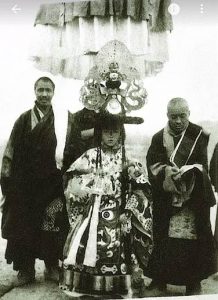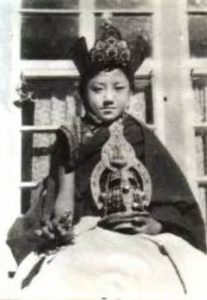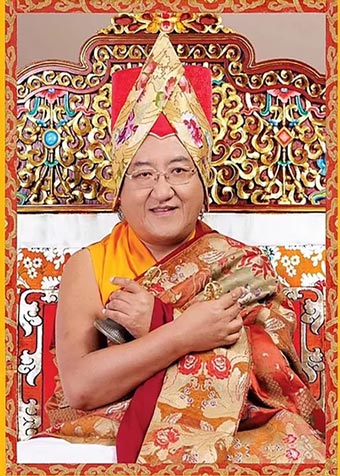The Birth of His Holiness
His Holiness the Sakya Trichen was born at sunrise on the morning of the first day of the eighth lunar month in the year of the Wood Bird, or on September 7, 1945. His birth occurred painlessly in the very same blessed room where Kunga Rinchen, who revitalized the Sakya doctrine, had been born more than ten generations earlier. There were many auspicious signs that heralded his birth. During his birth, the entire sky was festooned with extraordinary rainbows. Soon afterwards, an eighty-year old man with a head of white hair made an offering of a thangka of long life deities, butter and cheese to His Holiness. The milk of one hundred dri’s or female yaks was also offered in a crystal vessel by a handsome youth clad in white, who claimed to have been sent by the chieftain of Tsedong. However, when enquiries were made, no trace of this young man could be found.
Many prayers, special initiations, and rituals were performed to safeguard the life of His Holiness. Soon after his birth, in keeping with the tradition of the Dolma Palace, he received the initiation of a long life deity from Ngaglo Rinpoche. His Noble Father and Ngaglo Rinpoche gave him the Sanskrit name Ayu Vajra which means Long Life Vajra. This inaugurated a tradition of giving Sanskrit names to the sons of the Khön family.
There were a number of signs that indicated that His Holiness was also the reincarnation of the great Terton Orgyen Thrinley Lingpa (Apam Terton). Apam Terton was the true regent of Padmasambhava and possessed the attributes of a noble being with great spiritual realization. His body could pass through solid objects and he had discovered many ‘treasure teachings.’
The first indication that His Holiness was a reincarnation of Apam Terton occurred when a dakini prophesied to Apam Terton that he would hold the throne of Sakya in his next life. As a very young child, when His Holiness’ Noble Father and mother asked him where he came from, he answered that he came from far away and that his home was a tent. When he first began to talk, he spoke in the Golok dialect, which was the dialect spoken by Apam Terton. Once when Apam Terton’s son came to visit the Khön family, His Holiness’ aunt asked him who this man was. His Holiness replied that this was his son. When he met a disciple of Apam Terton called Sheija, His Holiness repeated a piece of advice given to him using the same words that Apam Terton had spoken earlier. He even called him Thubten Sheija: only Apam Terton and a few close people had known that Thubten was Sheija’s first name.
There were other signs to show that he was the reincarnation of Apam Terton. On the day of His Holiness’ birth, someone offered an image of Padmasambhava. This was an auspicious sign and it was considered a further indication that he was the reincarnation of Apam Terton. Another auspicious connection was the fact that during his first meeting with Jamyang Khyentse Choekyi Lodro, he received the transmission of the complete cycle of Longchen Nyingthig teachings from him. In 1949 when Apam Terton’s son visited His Holiness, Vajradhara Ngawang Kunga Rinchen, the father of His Holiness was concerned that Apam Terton’s son might request the return of his father’s reincarnation. However the son said, ‘The great terton purposely took birth in the Sakya Khön family to uphold the Sakya doctrine. I have no intention of requesting his return.’
When His Holiness was a few weeks old, a large celebration was held during which his birth was publicly announced. At that time he received his formal name, which is Ngawang Kunga Thegchen Palber Thrinley Samphel Wanggi Gyalpo. His aunt who took care of him after his mother passed away, said he was a child with exceptional qualities. The extraordinary signs that have always accompanied him bore witness to his realization. He was a very well behaved child and showed many signs of special qualities. As a young child, he pretended to do fire pujas and made toy tormas which he tossed away in imitation of the ritual of disposing of the effigy. He also used to imitate chanting and rituals. When Lama Ngaglo Rinpoche saw these things he said, ‘There is no doubt that he will be a great teacher, with high accomplishment and spiritual power.’
Early Childhood
His Holiness received his first major annutara yoga tantra empowerment in 1948 at the age of three, along with many other empowerments. His first empowerment was an empowerment of the Khön tradition, which was bestowed upon him elaborately and with great care by his noble father, Ngawang Kunga Rinchen according to the Khön tradition.
He remembers this well and believes that by the blessing power of that empowerment, he has not encountered any major obstacles to any of his activities.
At the end of the first lunar month in 1950, His Holiness’ older sister Ayang contracted a fever and passed away. His Holiness was very upset, but even before he had a chance to fully recuperate from the untimely demise of his beloved sister, his noble father became ill and due to his disciples’ lack of merits, entered into parinirvana on the eighth day of the second lunar month.
This was a sad time for the children of the family. His Holiness and his sister felt great sorrow, and their aunt who herself had suffered many grievous losses, took on the responsibility of caring for him and for his sister. She supervised the overall operation of the Sakya tradition and also administered Dolma Phodrang. She played a pivotal role in preserving and disseminating the traditions during this period.
Under the guidance of Khenchen Jampal Sangpo, she ensured the errorless performance of all the Vajrayana rituals. She also took charge of the offerings and sponsorships for the funeral ceremony, including the cremation and the preservation of the relics of His Holiness’ noble father.
Early Education
Along with many other empowerments, Lama Ngaglo Rinpoche gave His Holiness the special empowerment of the orange Manjushri. It was in the presence of a very holy statue of Manjushri that His Holiness first learned how to read from Lama Ngaglo Rinpoche. He learned the first letters of the Tibetan alphabet from a specially blessed scroll written in golden ink by Sachen Kunga Lodro which had previously been used by the successive Dungsays of the Khön Lineage. His first tutor was Kunga Gyaltsen who taught him the fundamentals of reading, writing and recitation of prayers. His Holiness diligently learned how to read until he completely mastered the art. He believes that this was the foundation of his excellent reading skill, which is one of his many remarkable qualities.
In the autumn of 1950 His Holiness travelled to Ngor E-wam Choeden in Tibet to receive the exoteric Lam Dre teaching from his root guru, the great abbot Vajradhara Ngawang Lodro Shenpen Nyingpo. The moment he saw his guru, a great devotion arose in him, and His Holiness realized that the great abbot had been and would be his guru in every lifetime. In the same year, during an extensive ritual for his long life, His Holiness recited the verses of response by heart, agreeing to live long. This was considered a very admirable feat for one so young. In 1951, when His Holiness was six years old, he began to memorize the very important texts of tantra.

Enthronement & Departure for India
Many rituals were performed during 1958 in preparation for His Holiness’ enthronement, which was scheduled for the following year. The ceremony took place the following year, when he was fourteen years old, beginning with a seven-day ritual followed by an elaborate three-day-long ceremony during the first lunar month. More than a thousand monks attended, and many great lamas and high-ranking government officials sent representatives who made elaborate offerings.
That year, His Holiness and his entire entourage left Tibet for India.
The Establishment of the Sakya Order in India
In 1963, His Holiness established a Sakya monastery for Sakya monks and a settlement for the Sakya lay population in India. On the 16th of March 1964, the re-establishment of Sakya Monastery was celebrated in a large, rented hall in Rajpur. Many auspicious omens were seen.
Later on, there was discussion between His Holiness and Khenpo Appey Rinpoche about the importance of maintaining a constant and continuous effort to revive the Dharma. This gave birth to an idea to establish an institute of Buddhist philosophy. As a result, a curriculum was prepared, and Sakya College was established. On December 19th, 1972, the 14th day of the eleventh lunar month (Sakya Pandita’s parinirvana day), the opening ceremony for Sakya College was held in a rented house. Khenpo Appey Rinpoche became its first Abbot and Principal. In the first lunar month of 1979, he presided over the foundation stone laying ceremony performed on the site of the future Sakya College. Later His Holiness established Sakya Institute in Puruwala. It’s first Abbot and Principal was Khenpo Rinchen Rinpoche. Both of these institutes provide education in higher Buddhist sutric and tantric studies. Among the scholars who graduated from both of these Institutes are many Khenpos, monastery directors, resident lamas, teachers, and translators who all contribute to the development and propagation of Lord Buddha’s teachings.
In 1974, in order to maintain the unbroken lineage of the Khön family, His Holiness consented, at the request of many Lamas and of his own aunt, to accept Tashi Lhakee as his Dagmo (consort). She was the daughter of Dege Hochotsang, head of a high noble family in the kingdom of Dege, Kham, an Eastern Province of Tibet. Dagmo Tashi Lhakee’s arrival at the Dolma Phodrang was followed by numerous auspicious signs, including the successful births of two Dungsays.
In the same year His Holiness travelled abroad for the first time. He visited Switzerland, England, Canada, USA, Japan, and Thailand. During that trip he made his first public addresses in English in England, birthplace of the English language. This was an auspicious coincidence. Since then, he has visited many other countries.
On 19th November 1974, Dagmo Kusho Tashi Lhakee gave birth to H.H. the 42nd Sakya Trizin, Ratna Vajra Rinpoche.
On 5th July, 1979 Dungsay Gyana Vajra Rinpoche (the younger son of His Holiness) was born. Many remarkable signs appeared.
The Excellent Qualities and Noble Activities of His Holiness
His Holiness has also transmitted many other teachings he received from his gurus. Due to his scholarship and to the eloquence of his discourses, his teachings always generate great reverence and inspire people from all walks of life, irrespective of race, culture, class, creed, nationality, or language.
His Holiness has always worked untiringly for the preservation and propagation of the precious teachings of both sutric and tantric traditions of Tibetan Buddhism and has ensured the continuity of a new generation of well-trained teachers and practitioners by founding monasteries and institutes for the higher study of Buddhist philosophy.
Having received teachings from the four major schools of Tibetan Buddhism, he is able to bestow empowerments in all traditions and he gives teachings to high lamas of all traditions. In this way he enriches all schools and holds his place as a great non-sectarian master, contributing to mutually enriching co-operation amongst the schools.
His Holiness has given teachings to many other high lamas of the other schools of Tibetan Buddhism. He has frequently discussed with other high lamas about ways and means of cooperating to uphold and promote the doctrine of the Buddha and preserve and foster the language and culture of the Tibetan people.
His abiding concern has always been for the preservation and propagation of Lord Buddha’s teachings and in particular those of the Sakyapa school. He is tireless in pursuing these goals. In spreading the Buddha Dharma, he is skilled in teaching each of his followers according to their individual mental disposition. Thus, his teachings are not only broad reaching but individually effective.
By scrupulously maintaining the five precepts, he has followed in the footsteps of all the great Sakyapa masters, pleasing his Gurus and all the Buddhas of the ten directions and the three times. Possessing genuine bodhicitta or the thought of enlightenment, he helps and benefits all sentient beings. As a Vajrayana Master, he has attained high realization and great skill in means.
Through realizing the selflessness of self and phenomena, he teaches with profound depth. Embodying relative and ultimate bodhicitta, his view is as vast as the ocean as he bestows teachings upon endless numbers of disciples. His behavior exemplifies the method of conduct of the bodhisattvas, a beacon lighting the way for all followers of the Buddha Dharma.
He is liberated from the extremes of samsara and nirvana. As all obscurations have been removed, he has attained all the supreme qualities. Because of our manifold obscurations, we are unable to see the Lord Buddha with our own eyes and receive his teachings directly. But due to the kindness of the guru, whom we can see in ordinary form, we are nevertheless able to receive through him the teachings and blessings of the Lord Buddha. His Holiness has come in human form to set an example for us, bound as we are by negative thoughts and actions. By exemplifying the kayas and wisdoms of the buddhas, he spreads the vast teachings of the result.
Out of compassion and altruism, His Holiness has ensured the continuation of the Sakya Khön lineage for the sake of all sentient beings. To preserve the unbroken lineage teachings and the tradition of the Khön family, he has ensured that his two sons receive an extensive education in the Buddha Dharma.
His Holiness has encouraged the propagation of the holy Dharma throughout the world. He has established and supported Dharma centers, monasteries, and other Dharma institutions in many parts of the world.
He is always available to help karmically linked disciples to uphold the Buddha Dharma, encouraging them with material support, teachings, and guidance. Also, through his prayers and his all-pervasive benevolence, he extends blessings to all beings.
His Holiness also extends his infinite compassion and wisdom to fortunate disciples through his writings. To date he has published a detailed list of all the teachings he has received from various masters; an enumeration of the works of the great masters of the Sakyapa Order and a two-volume autobiography along with a brief version of this. He has also written profoundly upon Birwapa’s guru yoga puja and many other ritual texts and composed numbers of dedication prayers, long life prayers and prayers for swift rebirth, as well as many short verses on other topics.
His Holiness Sakya Trizin upholds the Buddhist doctrine in its entirety and has propagated the Buddha Dharma throughout the world. He has been a constant source of wisdom and compassion for all beings.
May his holy body enjoy perfect health and immortality;
May his precious teachings illuminate the world forever;
May all disciples steadfastly keep their vows and practices;
May all sentient beings swiftly attain complete buddhahood.
Extracted from A Summary Based on the Biography of His Holiness the Sakya Trichen, prepared by His Holiness the 42nd Sakya Trizin, Ratna Vajra Rinpoche et al.


